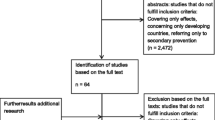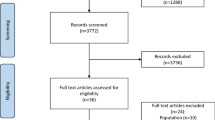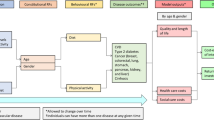Abstract
In cost-effectiveness analyses, models are used typically to synthesize the best available data and/or extrapolate beyond clinical trial data. Ideally, models should be validated both internally and externally. The purpose of this paper is to suggest a test for internal validation of models where several interventions for the same clinical indication are compared. To the best of our knowledge, such a specific test does not yet exist. There are four versions of the test, which consider the relationship between incremental downstream costs and effects in the case of a single or several endpoints. We apply two versions of the validation test to published cost-effectiveness analyses of physical activity programs and demonstrate internal validity of the model in one study and lack of internal validity of the model in the other study.
Similar content being viewed by others
Notes
Treatment of SEs can include interventions such as emergency surgery after failed coronary angioplasty.
Alternatively, we can consider an intermediate endpoint in the denominator.
This is the expected age of death used for calculating life years or DALYs lost.
Due to missing data we assumed that incremental costs and effects were not correlated, which overestimates the variance in cost-effectiveness and thus lowers the probability of detecting a significant difference.
References
Ainsworth, B.E., Haskell, W.L., Whitt, M.C., Irwin, M.L., Swartz, A.M., Strath, S.J., O’Brien, W.L., Bassett Jr, D.R., Schmitz, K.H., Emplaincourt, P.O., Jacobs Jr, D.R., Leon, A.S.: Compendium of physical activities: an update of activity codes and MET intensities. Med. Sci. Sports Exerc. 32(9 Suppl), S498–S504 (2000)
Airoldi, M., Morton, A.: Adjusting life for quality or disability: stylistic difference or substantial dispute? Health Econ. 18(11), 1237–1247 (2009)
Birch, S., Gafni, A.: Cost effectiveness/utility analyses. Do current decision rules lead us to where we want to be? J. Health Econ. 11(3), 279–296 (1992)
Birch, S., Gafni, A.: Changing the problem to fit the solution: Johannesson and Weinstein’s (mis) application of economics to real world problems. J. Health Econ. 12(4), 469–476 (1993)
Buxton, M.J., Drummond, M.F., Van Hout, B.A., Prince, R.L., Sheldon, T.A., Szucs, T., Vray, M.: Modelling in economic evaluation: an unavoidable fact of life. Health Econ. 6(3), 217–227 (1997)
Chilcott, J., Tappenden, P., Rawdin, A., Johnson, M., Kaltenthaler, E., Paisley, S., Papaioannou, D., Shippam, A.: Avoiding and identifying errors in health technology assessment models: qualitative study and methodological review. Health Technol. Assess. 14(25). (2010)
Cobiac, L.J., Vos, T., Barendregt, J.J.: Cost-effectiveness of interventions to promote physical activity: a modelling study. PLoS Med. 6(7), e1000110 (2009)
Cromwell, J., Bartosch, W.J., Fiore, M.C., Hasselblad, V., Baker, T.: Cost-effectiveness of the clinical practice recommendations in the AHCPR guideline for smoking cessation. Agency for Health Care Policy and Research. JAMA 278(21), 1759–1766 (1997)
Garber, A.M., Solomon, N.A.: Cost-effectiveness of alternative test strategies for the diagnosis of coronary artery disease. Ann. Intern. Med. 130(9), 719–728 (1999)
Goldie, S.J., Kuhn, L., Denny, L., Pollack, A., Wright, T.C.: Policy analysis of cervical cancer screening strategies in low-resource settings: clinical benefits and cost-effectiveness. JAMA 285(24), 3107–3115 (2001)
Gray, A.M., Clarke, P.M., Wolstenholme, J., Wordsworth, S. (eds.): Applied Methods of Cost-Effectiveness Analysis in Healthcare: Handbooks in Health Economic Evaluation Series, vol. 3. Oxford University Press, Oxford (2010)
Herman, W.H., Hoerger, T.J., Brandle, M., Hicks, K., Sorensen, S., Zhang, P., Hamman, R.F., Ackermann, R.T., Engelgau, M.M.: Diabetes prevention program research group. The cost-effectiveness of lifestyle modification or metformin in preventing type 2 diabetes in adults with impaired glucose tolerance. Ann. Intern. Med. 142(5), 323–332 (2005)
Holtgrave, D.R., Qualls, N.L.: Threshold analysis and programs for prevention of HIV infection. Med. Decis. Making 15(4), 311–317 (1995)
Howard, P., Knight, C., Boler, A., Baker, C.: Cost-utility analysis of varenicline versus existing smoking cessation strategies using the BENESCO Simulation model: application to a population of US adult smokers. Pharmacoeconomics 26(6), 497–511 (2008)
Luce, B.R., Manning, W.G., Siegel, J.E., Lipscomb, J.: Estimating costs in cost-effectiveness analysis. In: Gold, M.R., Siegel, J.E., Russell, L.B., Weinstein, M.C. (eds.) Cost-Effectiveness in Health and Medicine. Oxford University Press, New York (1996)
O’Brien, B., Levine, M., Willan, A., Goeree, R., Haley, S., Blackhouse, G., Gent, M.: Economic evaluation of outpatient treatment with low-molecular-weight heparin for proximal vein thrombosis. Arch. Intern. Med. 159(19), 2298–2304 (1999)
Philips, Z., Ginnelly, L., Sculpher, M., Claxton, K., Golder, S., Riemsma, R., Woolacoot, N., Glanville, J.: Review of guidelines for good practice in decision-analytic modelling in health technology assessment. Health Technol. Assess. 8(36), iii–iv, ix–xi, 1–158 (2004)
Pinkerton, S.D., Holtgrave, D.R., DiFranceisco, W., Semaan, S., Coyle, S.L., Johnson-Masotti, A.P.: Cost-threshold analyses of the National AIDS Demonstration Research HIV prevention interventions. AIDS 14(9), 1257–1268 (2000)
Roux, L., Pratt, M., Tengs, T.O., Yore, M.M., Yanagawa, T.L., Van Den Bos, J., Rutt, C., Brownson, R.C., Powell, K.E., Heath, G., Kohl 3rd, H.W., Teutsch, S., Cawley, J., Lee, I.M., West, L., Buchner, D.M.: Cost effectiveness of community-based physical activity interventions. Am. J. Prev. Med. 35(6), 578–588 (2008)
Sendi, P.P., Craig, B.A., Pfluger, D., Gafni, A., Bucher, H.C.: Systematic validation of disease models for pharmacoeconomic evaluations. Swiss HIV Cohort Study. J. Eval. Clin. Pract. 5(3), 283–395 (1999)
Weinstein, M.C., Zeckhauser, R.: Critical ratios and efficient allocation. J. Public Econ. 2, 147–157 (1973)
Weinstein, M.C., O’Brien, B., Hornberger, J., Jackson, J., Johannesson, M., McCabe, C.: ISPOR Task Force on Good Research Practices–Modeling Studies. Principles of good practice for decision analytic modeling in health-care evaluation: report of the ISPOR Task Force on Good Research Practices–Modeling Studies. Value Health. 6(1), 9–17 (2003)
Conflict of interest
There are no potential conflicts of interest. The authors did not receive funding.
Author information
Authors and Affiliations
Corresponding author
Appendix
Appendix
Proof of version 3
Consider four interventions A, B, C, and D, which are compared in the short term in terms of the ratio of incremental downstream costs to incremental downstream effects:
where \( \theta \) and \( \vartheta \) are two constants used to equalize the ratios of incremental downstream costs to incremental downstream effects. The ratios for the different interventions are not the same unless clinical events do not differ in terms of costs and severity.
When all interventions prevent death by preventing clinical events over the period of effectiveness (condition 2), the resulting costs of survival until the next period are the same for each clinical event prevented, i.e., \( C_{\text{survival}} \) is identical for all interventions. Hence, the ratio of life extension costs to the weighted-average effect is the same for all interventions and thus can be denoted by a constant (\( K_{3} \)):
Deleting \( K_{3} \) and considering that the number of CEs avoided is a function of incidence (Inc) and relative risk reduction (RRR) yields:
When determining the relative change in cost-effectiveness beyond the trial period over the time horizon k we need to consider the relative change in incidence, death rate, and costs of clinical events:
When deleting \( \coprod\nolimits_{n = 1}^{k} {\left( {1 + \Updelta {\text{Inc}}_{{t_{n} - t_{n - 1} }} } \right)} \) from the denominator of each term, each term is multiplied with \( \coprod\nolimits_{n = 1}^{k} {\left( {1 + \Updelta {\text{Inc}}_{{t_{n} - t_{n - 1} }} } \right) \, \times \, \left( {1 - \Updelta \alpha_{{t_{n} - t_{n - 1} }} } \right) \times \left( {1 + \Updelta C_{{{\text{CE}}, \, t_{n} - t_{n - 1} }} } \right)} \). Hence, differences between interventions in terms of the ratio of incremental downstream costs to incremental downstream effects change proportional to \( \coprod\nolimits_{n = 1}^{k} {\left( {1 + \Updelta {\text{Inc}}_{{t_{n} - t_{n - 1} }} } \right) \times \left( {1 - \Updelta \alpha_{{t_{n} - t_{n - 1} }} } \right) \times \left( {1 + \Updelta C_{{{\text{CE}}, \, t_{n} - t_{n - 1} }} } \right)} \), thus proving version 3 of the test.
Proof of version 4
When extrapolating cost-effectiveness beyond the trial period over the time horizon k, we introduce factors k 1 and k 2 to describe that the relative change in incidence of each clinical event (\( {\text{Inc}}_{i} \)) and the relative change in death rate of each CE (\( 1 - \Updelta \alpha_{i} \)) stay constant over k periods. Using Eq. 11 as a basis we obtain Eq. 13.
When deleting \( k_{1} \times \sum\nolimits_{i = 1}^{m} {\left( {1 + \Updelta {\text{Inc}}_{i} } \right)} \) from the denominator of each term it is easy to see that each term is multiplied with \( k_{1} \times k_{2} \times \coprod\nolimits_{n = 1}^{k} {\left( {1 + \Updelta C_{{{\text{CE}}, \, t_{n} - t_{n - 1} }} } \right)} \). Hence, differences between interventions in terms of the ratio of incremental downstream costs to incremental downstream effects change proportional to \( k_{1} \times k_{2} \times \coprod\nolimits_{n = 1}^{k} {\left( {1 + \Updelta C_{{{\text{CE}}, \, t_{n} - t_{n - 1} }} } \right)} \), thus proving version 4 of the test.
Rights and permissions
About this article
Cite this article
Gandjour, A., Gafni, A. Internal validation of models with several interventions. Eur J Health Econ 14, 901–909 (2013). https://doi.org/10.1007/s10198-012-0434-3
Received:
Accepted:
Published:
Issue Date:
DOI: https://doi.org/10.1007/s10198-012-0434-3




